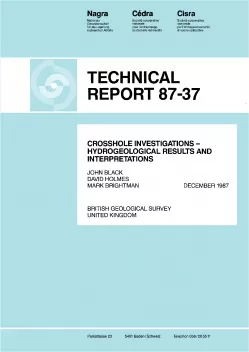
Technical Report NTB 87-37
Crosshole investigations –Hydrogeological results and interpretations
The Crosshole Programme was an integrated geophysical and hydrogeological study of a limited volume of rock (known as the Crosshole Site) within the Stripa Mine. Borehole radar, borehole seismic and hydraulic methods were developed for specific application to fractured crystalline rock.
The hydrogeological investigations contained both single borehole and crosshole test techniques. A novel technique, using a sinusoidal variation of pressure, formed the main method of crosshole testing and was assessed during the programme. The strategy of crosshole testing was strongly influenced by the results from the geophysical measurements.
The single borehole testing comprised roughly equal amounts of constant head and slug/pulse testing. Transmissivities varied between values around 1 × 10-12 m2 sec-1 and 5 × 10-7 m2 sec-1. For the most part high transmissivities were associated with geophysically identifiable fracture zones. Test zone lengths varied between 2 and 13 m and few tests were interpretable as single fissure responses.
The crosshole sinusoidal testing was carried out using computer-controlled test equipment to generate the sinusoidally varying head in a single zone (the "source") isolated by packers. A second ("receiver") borehole contained a number of straddle intervals and was used to observe the propagation of the sinusoidal signal. The number of positive responses was limited and flow appeared to be concentrated within a few "channels". Analysis was attempted using single fissure, regularly fissured and porous medium models. None gave satisfactory fits to the measured data. A new analysis involving the "dimension" of the flow test has been developed to analyse the results of the crosshole sinusoidal testing. This yields results involving "fractional dimensions" where flow may be assumed to occur within regions which do not fit within the existing 1, 2, and 3 dimensional models. This is a versatile analysis, well-suited to the sort of flow geometries likely to be found in crystalline rocks.
The longer term, larger scale hydrogeological response of the region was assessed by examining the variation of heads over the region. These were responding to the presence of an old drift. A method of overall assessment involving minimising the divergence from a homogeneous response yielded credible values of hydraulic conductivity for the rock as a whole.
